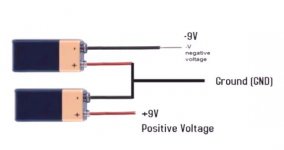It doesn’t need them, Vunce used them to reduce the wire stress/strain from flying lead mounting.
Aah, OK - thanks, X.
Andy
Given the extra time we now have from our current situation, I was able to get my Alpha Nirvana amplifier built. It’s a dual mono set up using Antek AS-3224 transformers, SLB psu’s with BJT helper boards for wiring(no snubber components), SSR DC speaker protection modules and an eBay softstart board(temporarily), All housed in a Modushop Dissipante 5U 400 case. The grounding scheme is handled by a single centrally located point with mains earth ground in direct contact with the perforated steel base and all AN/SLB PE’s and transformer screens stacked on top.
Voltage after the CRC is 29.5vdc, The SLB pots are adjusted to drop the most voltage possible (.7v) with keeping +/- equal, net voltage the AN module see is 28.8vdc. Bias voltage is rock steady after 10 minutes at .352v for 1.6A. DC offset is nonexistent at practically 0mV. These figures are actually amazing without any adjustment.
The AN board provides output power for the SSR DC protection boards which is very convenient. After 1.5 hours the top of the heat sinks are 47°C.
The amplifier is dead silent, I cannot hear any noise coming from the speaker with my ear right up to the drivers. The last detail will be the front panel, I haven’t decided on what type of switch I will use and it needs to be dressed up a little bit, it’s just a plain flat black boring face.
Thank you Hugh, X, JP and Jan for another well thought out fantastic project!! Now it’s time to enjoy it, let it break in and get some long-term listening impressions 😀
Voltage after the CRC is 29.5vdc, The SLB pots are adjusted to drop the most voltage possible (.7v) with keeping +/- equal, net voltage the AN module see is 28.8vdc. Bias voltage is rock steady after 10 minutes at .352v for 1.6A. DC offset is nonexistent at practically 0mV. These figures are actually amazing without any adjustment.
The AN board provides output power for the SSR DC protection boards which is very convenient. After 1.5 hours the top of the heat sinks are 47°C.
The amplifier is dead silent, I cannot hear any noise coming from the speaker with my ear right up to the drivers. The last detail will be the front panel, I haven’t decided on what type of switch I will use and it needs to be dressed up a little bit, it’s just a plain flat black boring face.
Thank you Hugh, X, JP and Jan for another well thought out fantastic project!! Now it’s time to enjoy it, let it break in and get some long-term listening impressions 😀
Attachments
-
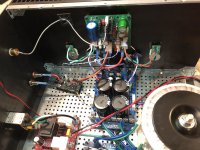 AD553795-DF4C-4B52-8C6B-98BAB1BADFAF.jpg993 KB · Views: 362
AD553795-DF4C-4B52-8C6B-98BAB1BADFAF.jpg993 KB · Views: 362 -
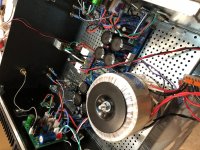 AF2AEB9C-2C98-4C12-9B53-2C8A9017B20C.jpg1,010.5 KB · Views: 363
AF2AEB9C-2C98-4C12-9B53-2C8A9017B20C.jpg1,010.5 KB · Views: 363 -
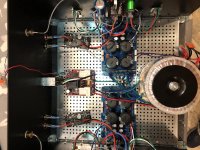 43A356D4-9CE6-4D57-B8E4-B56A533E581B.jpg1 MB · Views: 339
43A356D4-9CE6-4D57-B8E4-B56A533E581B.jpg1 MB · Views: 339 -
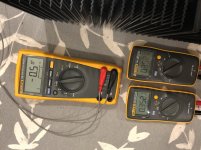 B3513A97-62AE-4E26-801E-35333EF3A9B4.jpg1 MB · Views: 318
B3513A97-62AE-4E26-801E-35333EF3A9B4.jpg1 MB · Views: 318 -
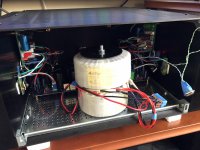 97CC0499-8554-4A9B-A532-71A9491672AB.jpg971.9 KB · Views: 353
97CC0499-8554-4A9B-A532-71A9491672AB.jpg971.9 KB · Views: 353
Looks great V! These suckers are quiet, listening to Amy W on mine at the moment and working on my M2X.
Man, in the last 6 months, I built 8 and am working on the 9th 🙂
Man, in the last 6 months, I built 8 and am working on the 9th 🙂
Very nice work, Vunce! That case is cavernous and looks like a good match for this amp. It would appear you have room for increasing the bias current some more for lower impedance or harder to drive speakers?
....All housed in a Modushop Dissipante 5U 400 case. The grounding scheme is handled by a single centrally located point with mains earth ground in direct contact with the perforated steel base and all AN/SLB PE’s and transformer screens stacked on top....
Really nice build! Congratulations! (Looks like you are using Clarity caps on the inputs, yes?) Looking forward to you listening impressions. And thanks indeed to the brilliant team that made it all possible.
I have a few mundane questions re. the Dissipante case, that I could not find the answers to in the diyAudio Store. Perhaps you or someone else could help.
1. Is the back panel drilled for the input and speaker connectors and power entry?
2. Is the perforated steel base seen in the photos optional, or is that the bottom of the case
3. Is your top aluminum or steel? Is one recommended over the other?
4. Does the front panel have a precut hole for a power switch.
5. Are the heatsinks drilled for attachment of stuff? I think the Deluxe cases are but I’m not sure about the Dissipante.
6. Pending the answers to the above, what is the advantage of the Deluxe case over the Dissipante to justify the extra cost?
Thanks,
Francois
This may help with a few of the questions re: holes / tapping and the deluxe.
FAQs (Frequently Asked Questions) – diyAudio Store
FAQs (Frequently Asked Questions) – diyAudio Store
Thanks for the kind words Fellas! Been listening all day to the AN and I like what I’m hearing 🙂
Francois,
The Dissipante chassis from Modushop doesn’t have any holes drilled in front/rear panels or heatsinks. The perforated baseplate is an extra charge, mine has aluminum top/bottom panels.
One criticism I have with this case, it’s large and most likely will be filled with heavy transformers but there are no support brackets for the middle of the top/bottom panels where they meet the front/rear panels. There is no way this chassis bottom plate could support the pair of transformers installed without using the steel perforated base plate, at this point it is not optional, it’s mandatory.
Francois,
The Dissipante chassis from Modushop doesn’t have any holes drilled in front/rear panels or heatsinks. The perforated baseplate is an extra charge, mine has aluminum top/bottom panels.
One criticism I have with this case, it’s large and most likely will be filled with heavy transformers but there are no support brackets for the middle of the top/bottom panels where they meet the front/rear panels. There is no way this chassis bottom plate could support the pair of transformers installed without using the steel perforated base plate, at this point it is not optional, it’s mandatory.
One criticism I have with this case, it’s large and most likely will be filled with heavy transformers but there are no support brackets for the middle of the top/bottom panels where they meet the front/rear panels. There is no way this chassis bottom plate could support the pair of transformers installed without using the steel perforated base plate, at this point it is not optional, it’s mandatory.
I suspect I will have the same (bending) problem with my 350mm deep SlimLine case. 🙁 But I've already ordered them - without steel perforated base plates.
What I intend to do is superglue a length of 3mm brass rod to the bottom of the case - projecting out, say, 3mm - then drill a corresponding hole in the back of the 10mm thick front panel to take the rod. This will stop the weight of the traffos from depressing the bottom of the case at the front (where the traffos are, in my build).
Andy
I suspect I will have the same (bending) problem with my 350mm deep SlimLine case. 🙁 But I've already ordered them - without steel perforated base plates.
What I intend to do is superglue a length of 3mm brass rod to the bottom of the case - projecting out, say, 3mm - then drill a corresponding hole in the back of the 10mm thick front panel to take the rod. This will stop the weight of the traffos from depressing the bottom of the case at the front (where the traffos are, in my build).
Andy
3mm brass Rod will not be strong enough to do the job. Why not just put a rectangular steel or aluminum plate under the transformers that runs the width of the chassis. Bolt the plate to the chassis and the transformers through the plate to the chassis. This should stiffen the chassis bottom and will mount the transformers securely. You could even use something like 1/2” Birch plywood if you have the chassis height available. This approach also offers some chassis damping.
Good ideas Bfpca.
Plywood makes for a very solid, sturdy base.
I have a few “ply-base” projects, haha!!
Plywood makes for a very solid, sturdy base.
I have a few “ply-base” projects, haha!!
Good ideas Bfpca.
Plywood makes for a very solid, sturdy base.
I have a few “ply-base” projects, haha!!
I like to repurpose used stuff to make chassis. I welded 2 UPS chassis together to make a tall chassis to build my Aleph J. I have used wood to mount transformers on in the past in order to move them up and away from the boards at the bottom, which prevented induced hum. My latest build, a USSA5, uses a chassis built from scraps of aluminum a wooden top and 1/2”mdf front panel.
I have just found this thread and the 39w amp looks like a great project, and displays innovative thinking and use of alternative build methods like CPU coolers and computer cases to get the job done. Very interesting.
Personally I think it’s time someone developed a worthy +- switching power supply to power class a or AB amps. I have had a lot of issues with toroids that buzz when asked to drive a big bank of capacitors and supply amps of DC.
Yes, the bottom plate of the Modushop chassis is not strong enough.
I've added a 18mm multiplex birch plate on which I can install all the heavy weights,
the multiplex is bolted to the bottom plate.
I've added a 18mm multiplex birch plate on which I can install all the heavy weights,
the multiplex is bolted to the bottom plate.
Last edited:
Personally I think it’s time someone developed a worthy +- switching power supply to power class a or AB amps. I have had a lot of issues with toroids that buzz when asked to drive a big bank of capacitors and supply amps of DC.
Now that you bring that up, I'd like to mention that I've been thinking the exact same thing. And I don't think it's impossible or even difficult.
All you'll need is two switching PSU's of the type that you can float the ground so as to avoid a short when connecting to mains. Then connect them up in a +- way. That in itself is quite easy, as illustrated in the picture. In fact, I've already tested it with two 12V server PSU's that I had in my workshop and the concept works, except the voltage is too low for Pass amps.
Attachments
I successfully used two 24v 5A SMPS bricks for LED lighting in series on a Pass M2. They don’t have a connection to earth ground even though it’s a 3 prong EIC socket (!). Works quite well. These were the same 24v PSUs I used to power my MOFO. They don’t like to run close to 5A limit as they get quite hot. I would get four of them for any long term use.
Strange Forest of Noise with Linear PSU
SUPERNIGHT Power Adapter, Transformers, Power Supply for LED Strip, Output 24V DC, 5A Max, 120 Watt Max, UL Listed (Output 24V DC, 5A) Amazon.com: SUPERNIGHT Power Adapter, Transformers, Power Supply for LED Strip, Output 24V DC, 5A Max, 120 Watt Max, UL Listed (Output 24V DC, 5A): Electronics
Strange Forest of Noise with Linear PSU
SUPERNIGHT Power Adapter, Transformers, Power Supply for LED Strip, Output 24V DC, 5A Max, 120 Watt Max, UL Listed (Output 24V DC, 5A) Amazon.com: SUPERNIGHT Power Adapter, Transformers, Power Supply for LED Strip, Output 24V DC, 5A Max, 120 Watt Max, UL Listed (Output 24V DC, 5A): Electronics
Last edited:
There are circuit types for SMPS that have very low noise output. There are some other issues but most are dealt with fairly easily. You need to start with a good quality supply . There is some real junk out there on EBay that is billed as a +- dc smps but they are not regulated. The output varies with the input voltage. I bought one that was 500w +_30v just to see what it actually put out for voltage. The RFI coming out of these is pretty horrendous. You can’t get within 6” of it with a scope probe and you can fill the screen. The output noise waveform is a square wave.
A good quality medical grade supply on the other hand will have low noise output and low leakage current. These are a good starting point. There is a whole new generation of SMPS out there lately using GaAs transistors for increased efficiency. The Pass designed ACA uses a smps. I built one and used a good quality used 24v SMPS I had on hand. Dead quiet at the speaker. Turn on surge limiting is built into the supply and no transformer buzz to worry about. A lot of positives. Are these generic type supplies good enough? Some will say not. You could try to design your own using a topology that is low noise. Hypex makes a supply that they use with their high power class D amplifiers. I’m not sure if those supplies are designed to output the constant power required for a class A amplifier?
A good quality medical grade supply on the other hand will have low noise output and low leakage current. These are a good starting point. There is a whole new generation of SMPS out there lately using GaAs transistors for increased efficiency. The Pass designed ACA uses a smps. I built one and used a good quality used 24v SMPS I had on hand. Dead quiet at the speaker. Turn on surge limiting is built into the supply and no transformer buzz to worry about. A lot of positives. Are these generic type supplies good enough? Some will say not. You could try to design your own using a topology that is low noise. Hypex makes a supply that they use with their high power class D amplifiers. I’m not sure if those supplies are designed to output the constant power required for a class A amplifier?
I had a great luck with a cheap $40 Aliexpress 800w SMPS designed for LED's, while a $150 one supposedly designed for "audio" from Connexelectronic was just noisy hiss and hum that was not tolerable. These were for my TPA3255 Class D amp.
Look at the noise baseline of this cheap PSU - there is no mains hum or harmonics:
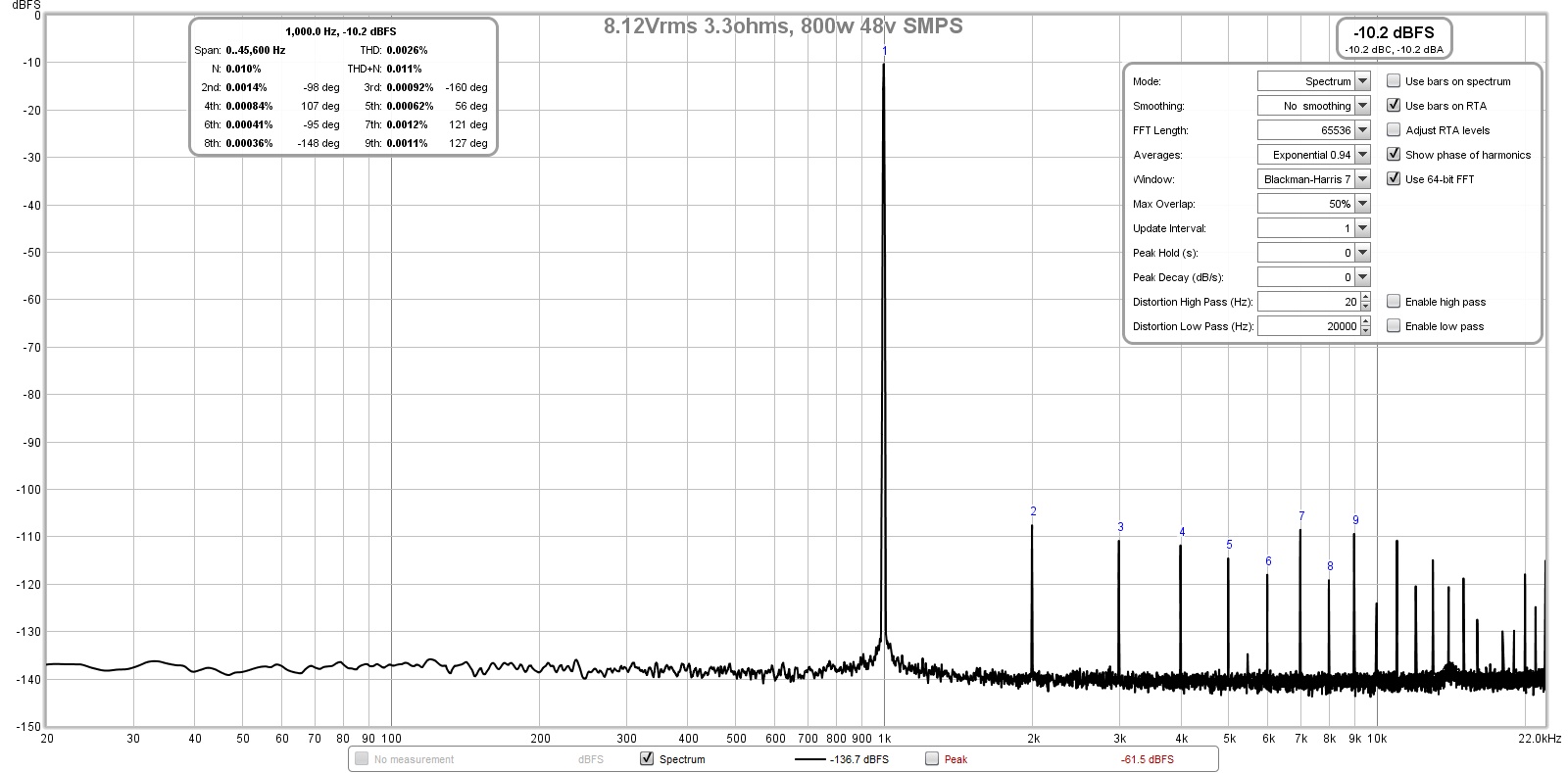
Here is the PSU in action:
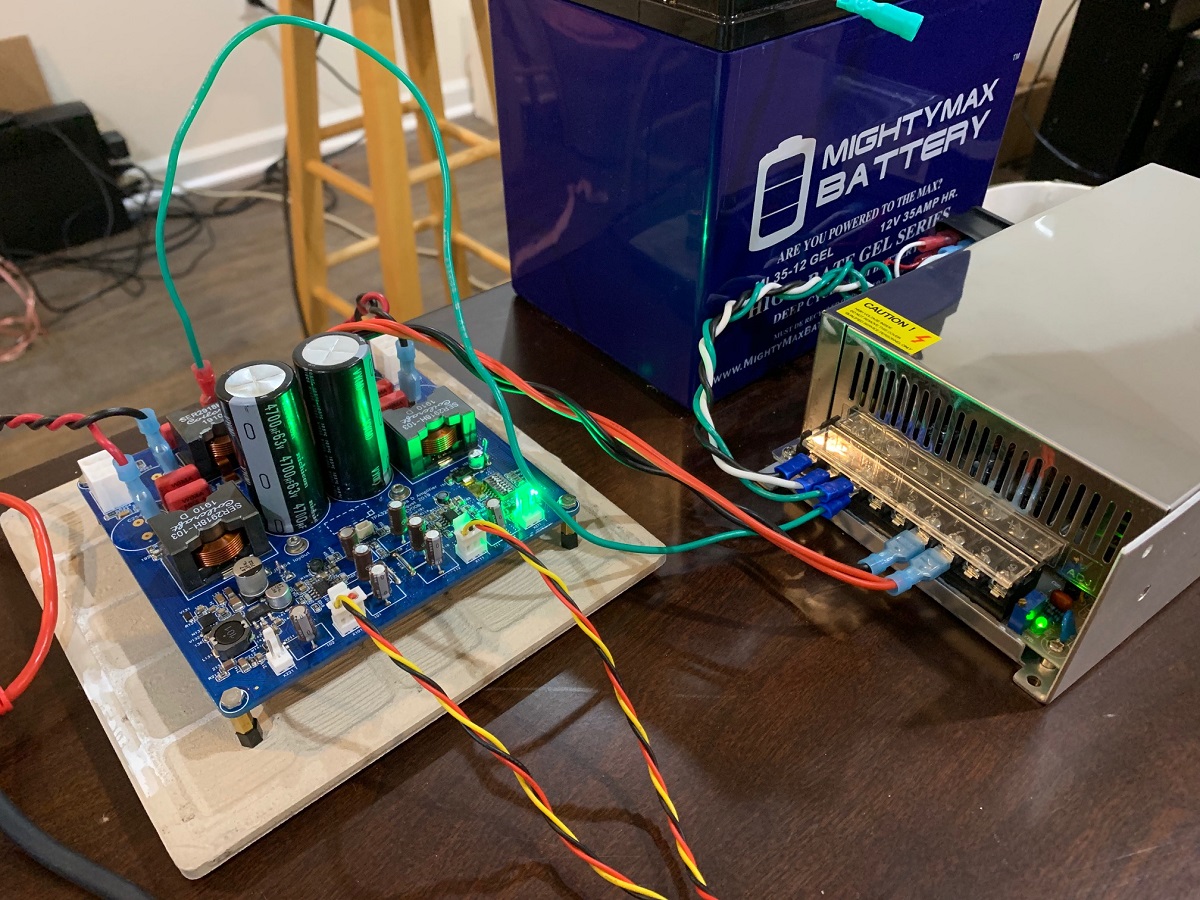
Whatever topology it was, it works well.
Now, if we could only put these in series...
Look at the noise baseline of this cheap PSU - there is no mains hum or harmonics:
Here is the PSU in action:
Whatever topology it was, it works well.
Now, if we could only put these in series...
Last edited:
You should be able to put them in series. At one point I remember seeing a commercial offering that was designed specifically to be put in series. The 2 supplies were connected together with some extra signal connections that locked the operating frequencies together. If not you could have different operating frequencies and possible noise in the audio band due to the difference frequency. I have doubts about that really being a problem. Did you do any additional filtering on the output of that supply pictured above?
A constant load of several amps for class A is a different ball game than a Class D amp. The spectrum shown above is quite impressive and shows clearly the advantage of removing the line frequency from the power supply equation.
A constant load of several amps for class A is a different ball game than a Class D amp. The spectrum shown above is quite impressive and shows clearly the advantage of removing the line frequency from the power supply equation.
- Home
- Amplifiers
- Solid State
- Alpha Nirvana 39w 8ohm Class A Amp

